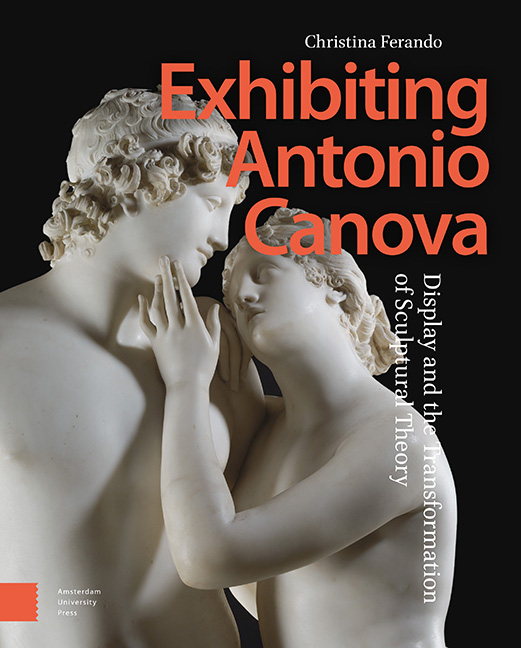Book contents
- Frontmatter
- Table of Contents
- List of Illustrations
- Acknowledgements
- Introduction: Canova on Display
- 1 Imagining Sculptural Practice
- 2 Reevaluating Ancients and Moderns
- 3 Anatomizing the Female Nude
- 4 Challenging the Supremacy of Painting
- 5 Defining Modern Sculpture
- Conclusion: Aftereffects
- Bibliography
- Index
4 - Challenging the Supremacy of Painting
Published online by Cambridge University Press: 13 February 2024
- Frontmatter
- Table of Contents
- List of Illustrations
- Acknowledgements
- Introduction: Canova on Display
- 1 Imagining Sculptural Practice
- 2 Reevaluating Ancients and Moderns
- 3 Anatomizing the Female Nude
- 4 Challenging the Supremacy of Painting
- 5 Defining Modern Sculpture
- Conclusion: Aftereffects
- Bibliography
- Index
Summary
Abstract: Chapter four, “Challenging the Supremacy of Painting,” focuses on the 1817 exhibition of Canova’s Polinnia in the newly opened public painting gallery of the Accademia di Belle Arti in Venice. The new director, Leopoldo Cicognara, exhibited Canova’s Polinnia with recently restored Venetian Old Master paintings, including Titian’s Assumption of the Virgin. In the confrontation between these two Venetian masters who both excelled at the depiction of flesh, Cicognara constructed a clear, understandable narrative for a diverse audience that merged politics and aesthetics. He literally enacted the paragone, or competition between painting and sculpture, to reaffirm the Veneto’s artistic authority in a moment of political decline.
Keywords: Academy of Fine Arts in Venice, Titian, paragone, Venice, Assumption of the Virgin, Polyhymnia
As we have seen, the significance of Canova’s sculptures was regularly established through comparisons with other well-known works of art. The juxtapositions between Triumphant Perseus and the Apollo Belvedere, and the Venus Italica and the Venus de’Medici are just two of the best-known examples. While Canova’s work was frequently aligned with or contrasted to ancient sculpture, associations with more modern works of art were also equally important. In Venice, for instance, in honor of the inauguration of the painting galleries of the Accademia di Belle Arti (Academy of Fine Arts) in 1817, Canova’s Polinnia stood in the grand salon of the Accademia, surrounded by some of the greatest Venetian paintings of all time. His sculpture and Titian’s recently restored Assumption of the Virgin (1516–1518) were the highlights of the show. Canova and Titian were both hailed for their ability to depict flesh, but it was not just the handling of material that linked the two artists. By creating a direct link between the Old Masters, their past triumphs, and the present ascendancy of the arts under Canova, the exhibition vaunted the constancy and continued excellence of the Veneto’s artistic tradition in contradistinction to its changing political fortunes. Positioning Canova’s Polinnia in a room full of Venetian paintings also elicited critical issues regarding the language of art by raising the specter of the paragone, the contest between painting and sculpture.
- Type
- Chapter
- Information
- Exhibiting Antonio CanovaDisplay and the Transformation of Sculptural Theory, pp. 177 - 216Publisher: Amsterdam University PressPrint publication year: 2023



